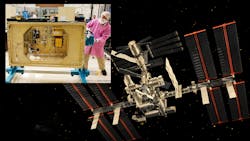Space-Based SDR: NASA’s ScaN Testbed (Download)
Developing electronics for space applications is certainly an exciting task, but it can become a real problem if the designer fails to address the critical robustness requirements of the application. It’s crucial to consider not only the harsh environment of space, but also the fact that physical maintenance is very scarce and expensive. Therefore, it’s not a surprise that RF devices for space communication are evolving from fixed and single-purpose hardware-based systems to flexible, robust, and reprogrammable software-defined radios (SDRs).
To ensure proper operation in space, SDRs must be prepared to endure harsh conditions. Thus, they must employ radiation-hardened electronics; comply with limited size, weight, and power (SWaP) requirements; and allow for remote control and programming from ground stations. To verify the feasibility of using SDRs in space, experiments ensued in the SCaN (Space Communications and Navigation) testbed.
